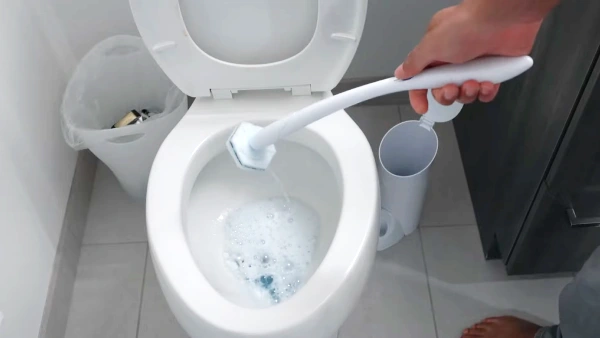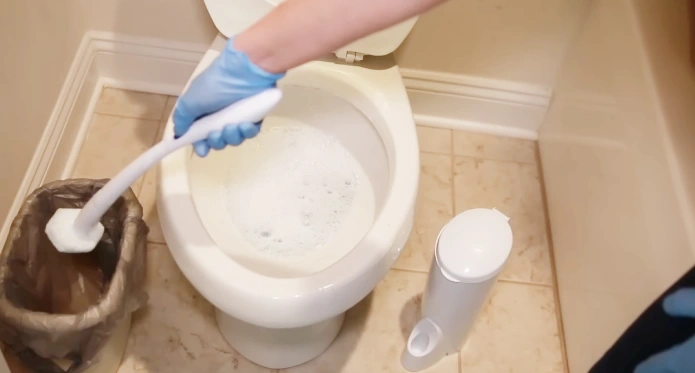Last Updated on October 17, 2023
The Clorox toilet wand is a popular household cleaning tool designed to simplify the often-dreaded task of cleaning toilet bowls. It is a convenient and hygienic alternative to traditional toilet bowl brushes and scrubbers. Now you might think, is Clorox ToiletWand flushable to save you from dealing with the dirty mess?
Clorox ToiletWand is not designed to be flushed down a toilet. It contains plastic components, which can cause clogs and other plumbing issues if not disposed of properly. Also, the wand contains cleaning chemicals, such as chlorine bleach, which can damage your pipes and septic system.
In the following article, we will explore why Clorox ToiletWand is not recommended for flushing. We’ll also discuss what to do if you accidentally flush a Clorox ToiletWand. Let’s get started.
Are Clorox ToiletWand Flushable: Practical Facts

If you’re wondering why Clorox ToiletWand is not flushable, there are several reasons to think about.
- Reason 01: Material Composition
- Reason 02: Negative environmental Impact
- Reason 03: Increase sewer System Maintenance Costs
- Reason 04: Not recommended by the manufacturer
- Reason 05: Local Regulations and Guidelines
Let’s discuss each of these reasons in more depth so you can understand why flushing the Clorox ToiletWand is not recommended.
Reason 01: Material Composition
In contrast to toilet paper, the ToiletWand’s cleaning heads are made from foam, sponge, and plastic, which do not dissolve in water.
These materials can accumulate in your pipes over time and lead to clogs or damage your plumbing system. According to experts, flushing non-biodegradable items is one of the leading causes of blockages in toilets and sewer lines.
Reason 02: Negative Environmental Impact
Disposing non-flushable items improperly, such as the cleaning heads mentioned earlier, has significant environmental consequences. Flushing these items down the toilet can lead to them ending up in wastewater treatment facilities or natural water bodies.
Once in these environments, they may not break down easily and can cause harm to aquatic life or contribute to pollution. Aquatic organisms may mistake this debris for food, leading to ingestion-related problems and even death.
Reason 03: Increase Sewer System Maintenance Costs
Public sewer systems are greatly affected when non-flushable items are flushed down toilets. The improper disposal practices require additional resources and cost more for maintenance, repairs, and unclogging efforts. This puts a strain on the system and increases the costs for taxpayers or utility customers.
Besides public sewer systems, improper disposal of non-flushable items can also cause costly repairs in your home plumbing system. Removing non-flushable items that clog pipes and cause blockages requires extra manpower and equipment. Which ultimately translates to higher repair bills.
Reason 04: Not Recommended by the Manufacturer
Clorox ToiletWand manufacturers do not recommend flushing the product because it is designed for single-use cleaning purposes and is not biodegradable.
While the disposable cleaning heads are convenient for scrubbing toilets, they are not designed to break down easily in water like toilet paper. Flushing them can potentially clog pipes and contribute to plumbing problems.
To ensure proper disposal and prevent any plumbing issues, it’s best to dispose of the used cleaning heads in the trash as directed on the product packaging.
Reason 05: Local Regulations and Guidelines
Adhering to local regulations and guidelines is crucial for avoiding fines or penalties when disposing of non-flushable items down the toilet. Many municipalities have implemented strict rules to protect their sewage systems from potential damage caused by flushing inappropriate items.
These regulations are evidence-based and informed by the knowledge that certain materials can clog pipes, cause blockages, and lead to costly repairs.
Therefore, you should consult with local authorities before assuming an item can be safely flushed.
What do you do if you flush a Clorox Toilet Wand?

If you find yourself in the unfortunate situation of having flushed a Clorox Toilet Wand, there are several methods you can try to retrieve it.
Method 01: Use a Plunger
Sometimes, you can dislodge the item with a toilet plunger by creating a good seal over the drain hole and gently pushing and pulling to create suction. This method is effective because it utilizes the power of suction to remove the item stuck in the toilet.
When you create a seal with the plunger, it allows for pressure to build up, which can help dislodge the obstruction. Pushing and pulling create a vacuum-like effect that can loosen and move the item toward the drain.
Method 02: Retrieve with Tongs or Gloves
Using tongs or disposable gloves, you can safely retrieve the Clorox ToiletWand from the toilet bowl. This method is effective when the object is visible and within reach.
With tongs, you can grasp and lift the item without direct contact, minimizing potential contamination. Disposable gloves provide a barrier between your hands and the toilet water, ensuring hygienic handling of the object.
When using tongs, gently grip the item without exerting too much pressure that could cause it to break or be pushed further down the drain. Slowly lift it out of the water and place it in a plastic bag for disposal.
If you prefer disposable gloves, wear them before entering the toilet bowl. Carefully grab hold of the object and remove it from the water. Dispose of both gloves and items properly after retrieval.
Method 03: Drain Snake or Auger
To retrieve Clorox ToiletWand that has gone further down the toilet drain, use a drain snake or auger. The snake works by forcing its way through the pipes and gripping items so you can pull them out.
When using an auger, fully insert it into the toilet bowl. Manually spin the shaft until it comes in contact with the lost item. Slowly rotate the handle so that the auger’s claws can grip hold of it. Once secured, pull back firmly to remove the object from the drain. Dispose of it properly afterward.
Method 04: Shop Vac (Wet/Dry Vacuum)
Most professionals use a wet/dry vacuum called a Shop Vac to remove water and stuck items from toilet bowls without causing further damage. This method can be effective when dealing with stubborn clogs or objects difficult to reach with other tools.
To use a Shop Vac, carefully place the suction opening on the end of the hose over the object or clog and turn it on. The vacuum should suck up the water and clog, clearing your toilet bowl. Then, you can easily dump the Clorox ToiletWand refills into the bowl and use a brush or plunger to clear any remaining residue.
Method 05: Call a Professional Plumber
If the previous methods have yet to work for you, it’s time to consider calling a professional plumber. Plumbers have the knowledge and experience to handle more complex toilet blockages that may require specialized tools or techniques.
Hiring a professional can avoid potential damage to your plumbing system and ensure that the problem is resolved effectively.
Can I break down Clorox ToiletWand cleaning heads before flushing them?

To avoid plumbing issues, you should not attempt to disassemble Clorox ToiletWand cleaning heads. It is not effective to manually break down these cleaning heads since they are specifically designed with non-dissolvable materials.
The manufacturer recommends disposing of the used cleaning heads in the trash instead.
Be Mindful of Not Flushing Items Into the Toilet
Taking responsibility for the items we flush down our toilets is crucial for our plumbing systems and the environment. Flushing non-flushable items like Clorox ToiletWand cleaning heads can lead to blockages, plumbing damage, and environmental problems.
While prevention is the best approach, accidents can occur. Tools like plungers, drain snakes, or calling professional plumbers can help resolve the issue.
If you dispose of non-flushable items in the trash, you will ensure a smoother operation of your plumbing system and contribute to the environment’s health. Follow the manufacturer’s instructions when disposing of non flushable items.


